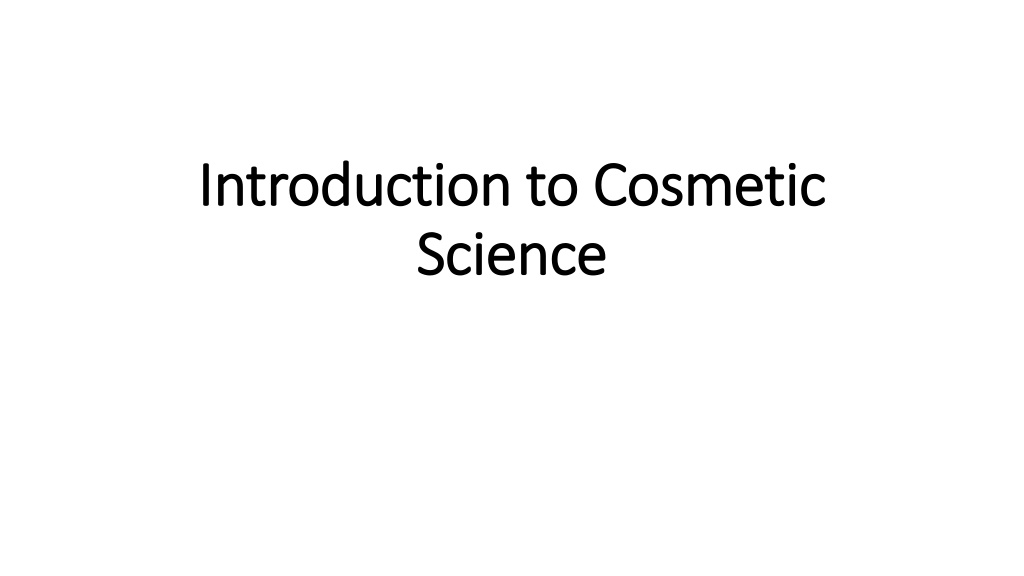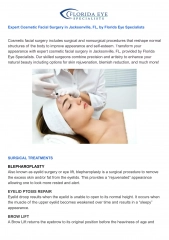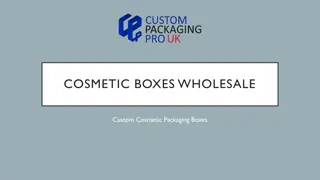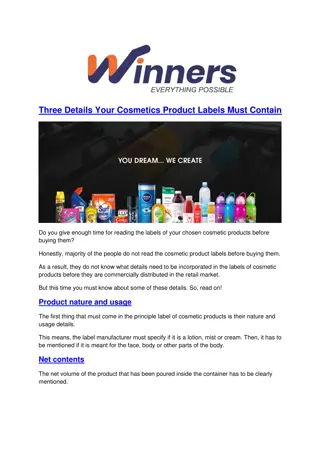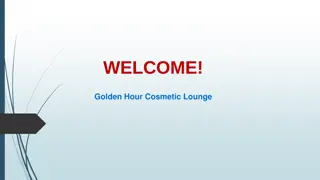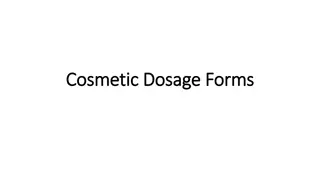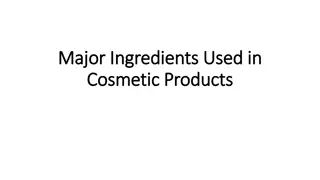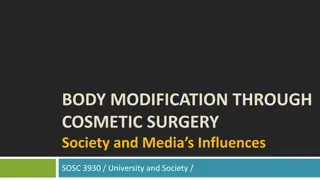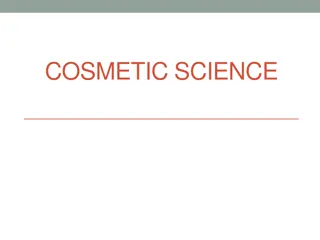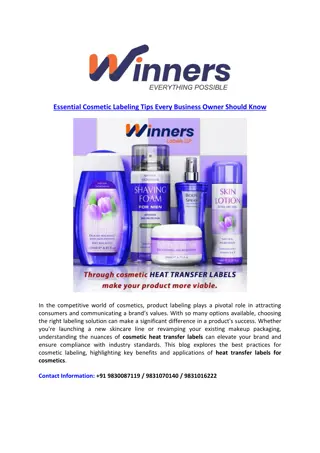Understanding Cosmetic Science: Essential Knowledge for Industry Scientists
Cosmetic science encompasses a blend of commercial, comparative, traditional, and borderline sciences. To excel in the cosmetic industry as a scientist, one needs a deep understanding of anatomy, physiology, chemistry, pharmacology, formulation technology, and regulatory guidelines. This article explores the fundamental knowledge required for success in this dynamic field.
Download Presentation

Please find below an Image/Link to download the presentation.
The content on the website is provided AS IS for your information and personal use only. It may not be sold, licensed, or shared on other websites without obtaining consent from the author. Download presentation by click this link. If you encounter any issues during the download, it is possible that the publisher has removed the file from their server.
E N D
Presentation Transcript
Introduction to Cosmetic Introduction to Cosmetic Science Science
What Is Cosmetic Science? Cosmetic science has been identified as follows: Commercial science that tries to find reasons for selling a product. Comparative science based on the fact that many manufacturers compare their own products to other manufacturers products and try to convince consumers why to buy their products instead of other companies products.
What Is Cosmetic Science? Traditional science, such as chemistry or physics, where there are hypotheses and scientists try to justify or deny them by performing a number of tests and reactions. Borderline science as it is a transition among a number of different scientific fields, including pharmacy, chemistry, dermatology, and marketing, among others.
What Knowledge Is Needed If Someone Wants To Work In The Cosmetic Industry As A Scientist Basic knowledge of anatomy and physiology is needed to understand the structure and function of the skin, hair, lips, teeth, and so on, to where products are usually applied. To be able to formulate effective, stable, and safe products that have appealing aesthetics, appropriate performance, and compatibility with the application surfaces, it is necessary to understand the basic physical, chemical, and physicochemical properties of the raw ingredients that are typically used. Therefore, a chemical background, including organic, inorganic, colloid, and polymer chemistry, is also required.
What Knowledge Is Needed If Someone Wants To Work In The Cosmetic Industry As A Scientist To be able to choose appropriate ingredients, the basic properties and therapeutic effects of the raw materials on the target surfaces have to be known. Therefore, a basic pharmacological education is also inevitable. Future formulators also need to be aware of and understand the different dosage forms from which they can choose to incorporate the ingredients. Additionally, they have to know the various manufacturing techniques that are used to produce the dosage forms. Therefore, they need to be taught formulation technology.
What Knowledge Is Needed If Someone Wants To Work In The Cosmetic Industry As A Scientist Knowledge and understanding of the current guidelines, rules, and regulations relevant for cosmetics and drug cosmetic products are essential. As part of the regulations, one needs to be aware of and understand the rules that regulate labeling and packaging of a final cosmetic product. Education in analytical sciences as well as microbiology is also important in order to understand the different types of tests and testing methods that are performed for cosmetics and OTC drug cosmetic products to evaluate their performance, efficacy, safety, and stability.
What Knowledge Is Needed If Someone Wants To Work In The Cosmetic Industry As A Scientist Additionally, understanding what consumers expect from products and what their needs are is also required in order to be able to target those needs and satisfy consumers (consumer needs). Finally, basic understanding of marketing and business is essential to understand how a business, such as the cosmetic industry, works.
Basic Definitions Is It a Drug or a Cosmetic? Cosmetics Articles intended to be rubbed, poured, sprinkled, or sprayed on, introduced into, or otherwise applied to the human body or any part thereof for cleansing, beautifying, promoting attractiveness, or altering the appearance without affecting structure or function. Among the products included in this definition are skin moisturizers, lipsticks, nail polishes, eye and facial makeup products, shampoos, permanent waves, hair coloring products, and deodorants as well as any material intended for use as a component of a cosmetic product.
Basic Definitions Drugs Articles intended for use in the diagnosis, cure, mitigation, treatment, or prevention of disease and articles (other than food) intended to affect the structure or any function of the body of man or other animals.
Basic Definitions Certain products can be cosmetics and drugs at the same time if they meet the definitions of both cosmetics and drugs. These products will be referred to as OTC drug cosmetic products (cosmeceuticals). Double function may happen when a product has two intended uses. For example, a shampoo is a cosmetic because its intended use is to cleanse the hair. An antidandruff ingredient is considered a drug because it is intended to be used to treat dandruff. Consequently, an antidandruff shampoo is both a cosmoceutical.
Other examples: Toothpaste that contains fluoride to prevent tooth decay. Antiperspirants that not only mask bad body odor but also alter the normal process of perspiration Mouthwash that contains ingredients to prevent and/or treat gingivitis (i.e., inflammation of the gums). Facial foundations that also contain sunscreens Facial cleansers that contain antiacne active ingredients Hand soaps that contain antibacterial agents to kill germs.
In addition to the US, the major markets for cosmetics are considered to be in Europe, Canada, and Japan. The definitions and regulations of cosmetics in these markets are slightly or significantly different from those in the US and also from one another. It means that the same product types may be categorized in a different way in different markets. It is especially important for companies that export their products from one country to another, since in this case, they have to meet the other countries definitions and regulations.
Popular Cosmetic Claims Many claims commonly used today for cosmetic products are not recognized or used by the FDA in any sense and have only limited scientific evidence behind them.
Organic Products Today, there is a growing consumer demand for products containing organic ingredients, also known as natural, ingredients. These ingredients are believed to be healthier and safer than their synthetic pairs. However, this is not necessarily true. An ingredient s source does not determine its safety.
Organic Products There are many toxins produced by animals and plants that are poisonous to the human body A common example is the poison (known as cyanogenic glycoside) found in apple seeds and apricot seeds. Their amount in a single apple or apricot is usually not enough to be dangerous to humans, but it is possible to ingest enough seeds to provide a fatal dose and eventually die.
Organic Products To many consumers, naturally sounding ingredients, such as aloe extract, chamomile extract, and lemon seed extract, mean natural ingredients and equal safety. However, it should be known that these ingredients can be synthetized in laboratories, which results in the exact same chemical structure and physical characteristics. Therefore, the name of an ingredient does not mean it has a natural origin.
Organic Products A general concern with natural ingredients is that they often contain a mixture of various ingredients, depending on the amount of light, humidity, temperature, and nutrients the plants received during cultivation. In the case of synthetic ingredients, their exact composition is always known and is easy to control; however, this is not true for natural products. Therefore, natural ingredients may have a higher chance of interactions with other ingredients in products.
Organic Products Additionally, we do not have an established safety profile for a number of natural ingredients, and we do not know whether they can cause allergic reactions, and if yes, to what extent. Moreover, the actual prevalence of adverse effects when using organic ingredients is often unrecognized or underreported. Therefore, consumers should be careful with natural ingredients as adverse effects, such as skin irritation, sensitizations, phototoxicity, and allergy, have been reported.
Organic products categories: Products in order to be labeled 100% organic must contain only organically produced ingredients. Products in the organic category must contain at least 95% organically produced ingredients. Products in the made with more than 70% organic ingredients contain at least 70% organic ingredients. They can be labeled made with organic ingredients.
Hypoallergenic Products Hypoallergenic cosmetics are products claimed to produce fewer allergic reactions than other non- hypoallergenic cosmetic products. Consumers with hypersensitive skin and even those with normal skin may be led to believe that these products will be gentler to their skin than non-hypoallergenic cosmetics. However, it should be noted that there is no standard or definition for the use of the term hypoallergenic.
Hypoallergenic Products Manufacturers of hypoallergenic cosmetics are not required to submit data and test results to the FDA to substantiate their hypoallergenicity claims. The term usually refers to products that do not contain ingredients known to cause allergic reactions, such as fragrances. However, as the use of the term is not regulated, it is recommended that consumers with sensitive skin check the list of ingredients on cosmetic labels and see whether there are any ingredients in the product that may cause problems to them.
Cruelty-Free Products Cruelty-free or Not tested on animals claims can often be found on labels or advertisements. Animal testing is a hot topic all over the world. Various animal protection organizations have protested against testing cosmetic products on animals, and in certain markets, testing has already been prohibited. In the EU, testing of finished products and ingredients on animals has already been prohibited. In addition, marketing of finished cosmetics that have been tested on animals or that contain ingredients that have been tested on animals is being prohibited after March 11, 2013
Cruelty-Free Products In the US, the FD&C Act does not specifically require the use of animals in testing cosmetics for safety. However, the agency advises cosmetic manufacturers to employ whatever testing is appropriate and effective for substantiating the safety of their products. Therefore, it remains the responsibility of the manufacturer to substantiate the safety of both ingredients and finished cosmetic products prior to marketing. It means that animal testing may be used to establish product safety.
Cruelty-Free Products Alternative methods to replace animal experiments, such as ex vivo studies (i.e., studies using tissues from an organism in an external artificial environment), have been developed in the past decade. However, they are still not accepted officially by the regulatory agencies in the US due to various reasons.
Cruelty-Free Products With respect to the cruelty-free and not tested on animal claims, there is no legal definition for them. Therefore, companies can use these phrases as they like. An important note is that, even if they use these terms for products that were not tested on animals, it does not mean that the raw materials were not tested on animals years ago when they were first introduced. The FDA says that a cosmetic manufacturer might only use those raw materials and base their cruelty-free claims on the fact that the materials or products are not currently tested on animals.
Preservative-Free Products Preservatives protect cosmetic formulations from microbiological contamination As the majority of cosmetic formulations contain water, protection against bacteria, molds, and yeast is essential. All products containing water should contain some types of preservative to provide appropriate beyond use date for their products and safety for consumers. Therefore, a preservative-free claim is questionable most of the time.
Preservative-Free Products We can rarely find products that have an acceptable shelf life without any preservatives. As the major problem is water, which necessitates the use of preservatives, products not containing water (the so- called anhydrous formulations) do not have to contain preservatives and can still have acceptable shelf life. Other product types that can claim to be preservative- free include formulations containing a higher percentage of ethanol, which is widely known to have an antimicrobial activity.
Preservative-Free Products In addition, certain products have a specific pH value that does not favor the growth of microorganisms. There are also special types of packaging materials, such as airtight packaging, which ensures the absence of organisms.
One of the most widely used preservatives are called the parabens. These ingredients are very effective even in very low concentration; however, they can cause allergic reactions in sensitive consumers. Additionally, they were linked to breast cancer and endocrine disruption. No study has confirmed the potential risks of using parabens on human health. As many consumers are afraid of using products containing parabens, many formulators have substituted parabens with other types of preservatives to ensure product longevity. They usually also claim their products to be paraben-free. If you see this claim on a product, it refers to the fact that the product does not contain parabens. However, it does not mean that it does not contain any sort of preservatives.
Another frequent claim with regard to preservatives is no added preservatives. It means that the product formulators did not add any ingredients to the formulation whose primary function would be preservation. However, there are a number of cosmetic ingredients that have a primary effect, such as skin conditioning, and have a limited antimicrobial property as well. In such cases, the ingredient added for its conditioning activity will also prevent microbial contamination in the product to a certain extent. These types of preservatives are usually called nonpreservative preservatives as their primary function is not the prevention of contamination. Their efficacy, however, may be not as good as that of parabens; therefore, formulations often have to use a higher amount of these ingredients.
Dermatologist Recommended Products The claim dermatologist recommended is commonly used on cosmetic products. It may lead consumers to believe that a medical panel of dermatologists has evaluated the product thoroughly and recommends it based on proven results. The truth is that there is no governing body requiring cosmetic companies to show data on whether a dermatologist, a few, or a large number of them tested and recommend a cosmetic product.
Dermatologist Recommended Products A dermatologist recommended claim is probably based on a product survey, and one or many dermatologists could have endorsed the product. It would also be valuable to know how many of them were neutral, disliked, or hated the product. In addition, it is also worth mentioning that even ingredients considered safe can initiate allergic reactions in sensitive patients. Therefore, unless the products were tested on a wide majority of users over an extended period of time, such a claim has only a little scientific value.
Clinically Proven Claims The claim clinically proven is scientific and powerful in the consumers mind. It should be noted that clinical testing is not required for cosmetic products that do not have drug claims. The clinically proven claim refers to the fact that a product was tested in a clinical environment on humans; however, the details of the clinical testing are usually not provided.
Clinically Proven Claims Important factors to consider in the case of clinical studies include the number of participants, whether they truly represent a wider group of usual consumers, skin condition of the participants (whether they had any skin sensitivity, allergy, skin disease, etc.), the use and type of a reference product, length of the study, frequency of application, use of other products, the type of data analysis used in the study, and many other factors. Therefore, the claim clinically proven without being aware of the study details is still not very informative.
Patented Formula Claims Another commonly used claim is the patented formula. Consumers believe that a product that has been patented must be more serious and scientific; therefore, it works better than other products. The truth is that patenting a product is often related to the technology of how the product is manufactured and not the actual effect of the product. Therefore, it does not necessarily mean that the product is more effective or has a longer performance.
pH Balanced Claims Companies that make pH balanced claims try to imply some level of superiority over products that do not make this claim. They want consumers to believe that the products will be less irritating and will work better. However, any decently formulated product is formulated in a pH range that is compatible with the skin, hair, underarms, or other application surfaces. A consumer will never notice a difference between a product that is pH balanced and one that is just normally formulated.
Classification of Cosmetic Classification of Cosmetic Products Products
Target Groups: A target group or target audience can be defined as a specific group of customers at whom a product is aimed. Target groups for cosmetics can include women, men, teenagers, and babies. Dosage Forms: A dosage form is the final physical form of a mixture of ingredients that consumers can take in their hands, purchase, and use. Legal Status: a product can be a cosmetic, a drug, or a combination of both, depending on the intended use.
Function: Cosmetics and OTC drugcosmetic products can have a variety of functions. Examples include: cleansing, which is the function of shampoos, bodywashes, hand soaps, and eye makeup removers moisturizing, which is the function of facial creams, hand creams, body lotions, aftershave balms, and cuticle softeners coloring, which is the function of many color cosmetics, such as lipstick, mascara, and blush protection, which is the function of sunscreens, diaper rash creams, and lip balms.
Application Surfaces: An application surface or area of application can be defined as a body surface to which cosmetics or OTC drug cosmetic products are applied. These can include the skin of the face, lips, eyelids, body, and hands; hair on the scalp and body and eyelashes; teeth and oral cavity; and nails, among others. Others: The cosmetic industry often classifies products into 5 6 different groups based on the combination of their function and application surface Popular categories include color cosmetics, skin care products, hair care products, oral care products, perfumes, and other products.
